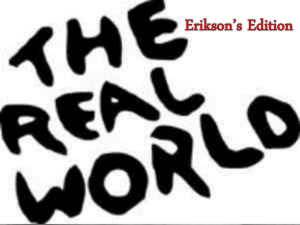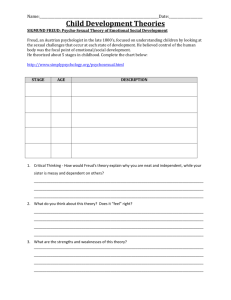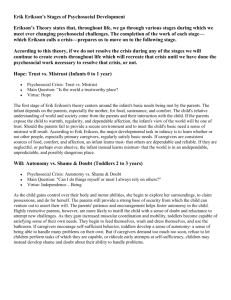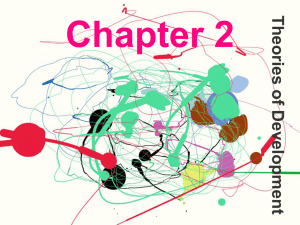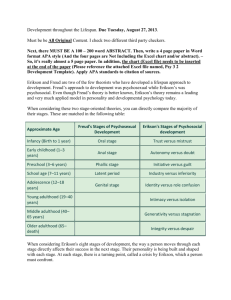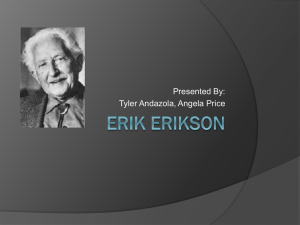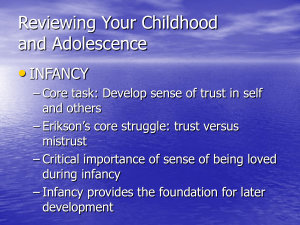erikson on stages of development
advertisement
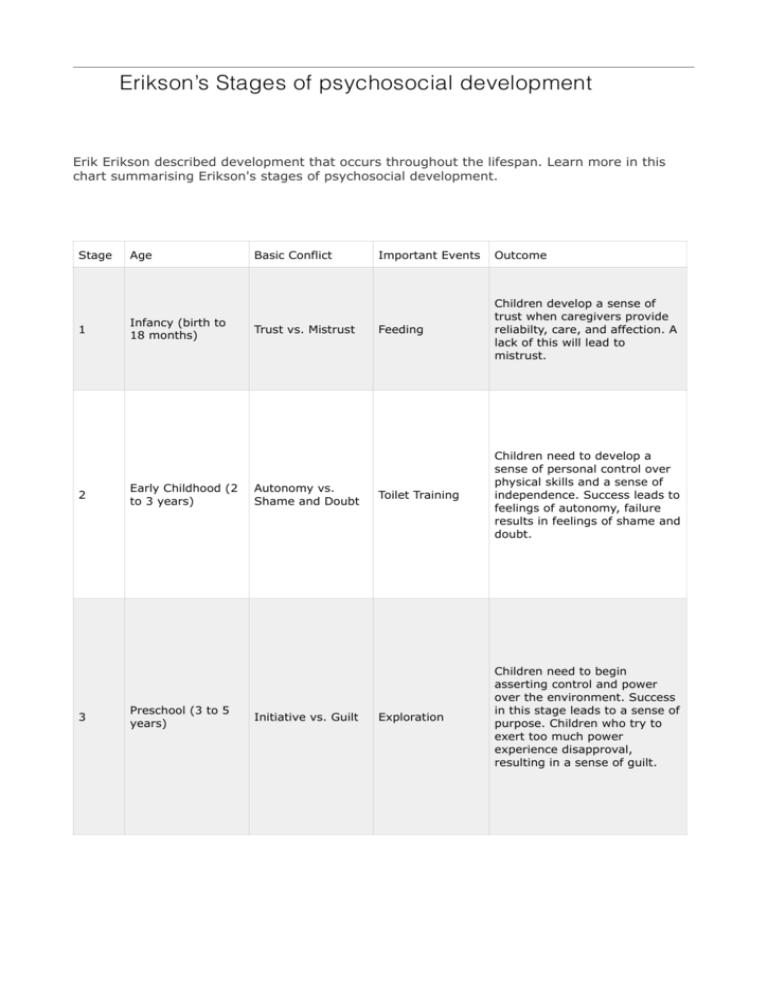
! ! ! Erikson’s Stages of psychosocial development Erik Erikson described development that occurs throughout the lifespan. Learn more in this chart summarising Erikson's stages of psychosocial development. ! Stage 1 2 3 Age Infancy (birth to 18 months) Early Childhood (2 to 3 years) Preschool (3 to 5 years) Basic Conflict Trust vs. Mistrust Autonomy vs. Shame and Doubt Initiative vs. Guilt Important Events Outcome Feeding Children develop a sense of trust when caregivers provide reliabilty, care, and affection. A lack of this will lead to mistrust. Toilet Training Children need to develop a sense of personal control over physical skills and a sense of independence. Success leads to feelings of autonomy, failure results in feelings of shame and doubt. Exploration Children need to begin asserting control and power over the environment. Success in this stage leads to a sense of purpose. Children who try to exert too much power experience disapproval, resulting in a sense of guilt. 4 5 6 7 School Age (6 to 11 years) Adolescence (12 to 18 years) Young Adulthood (19 to 40 years) Middle adulthood (40 - 65 years) Industry vs. Inferiority Identity vs. Role Confusion Intimacy vs. Isolation Generation v stagnation School Children need to cope with new social and academic demands. Success leads to a sense of competence, while failure results in feelings of inferiority. Social Relationships Teens need to develop a sense of self and personal identity. Success leads to an ability to stay true to yourself, while failure leads to role confusion and a weak sense of self. Relationships Young adults need to form intimate, loving relationships with other people. Success leads to strong relationships, while failure results in loneliness and isolation Work and Parenthood Adults need to create or nurture things that will outlast them, often by having children or creating a positive change that benefits other people. Success leads to feelings of usefulness and accomplishment, while failure results in shallow involvement in the world. 8 Maturity(65 to death) Ego Integrity vs. Despair Reflection on Life Older adults need to look back on life and feel a sense of fulfillment. Success at this stage leads to feelings of wisdom, while failure results in regret, bitterness, and despair. !! !! ! ! Stage 4 Industry v Inferiority !! For our purposes, we are going to focus on stages 4 and 5: Psychosocial Conflict: Industry versus Inferiority Major Question: "How can I be good?" Basic Virtue: Competence ! Important Event(s): School Industry versus inferiority is the fourth stage of Erik Erikson's theory of psychosocial development. The stage occurs during childhood between the ages of six and eleven. School and social interaction play an important role during this time of a child’s life. Through social interactions, children begin to develop a sense of pride in their accomplishments and abilities. During the industry versus inferiority stage, children become capable of performing increasingly complex tasks. As a result, they strive to master new skills. Children who are encouraged and commended by parents and teachers develop a feeling of competence and belief in their skills. Those who receive little or no encouragement from parents, teachers, or peers will doubt their ability to be successful. According to Erikson, this stage is vital in the development of self-confidence. During school and other social activities, children receive praise and attention for performing various tasks such as reading, writing, drawing and solving problems. Children need to cope with new social and academic demands. Success leads to a sense of competence, while failure results in feelings of inferiority. ! Stage Five Identity Versus Confusion ! !! !! Psychosocial Conflict: Identity Versus Confusion Major Question: "Who am I?" Basic Virtue: Fidelity Important Event(s): Social Relationships ! Identity versus confusion is the fifth stage of Erik Erikson's theory of psychosocial development. This stage occurs during adolescence between the ages of approximately 12 to 18. Teens need to develop a sense of self and personal identity. During adolescence, children are exploring their independence and developing a sense of self. As they make the transition from childhood to adulthood, teens may begin to feel confused or insecure about themselves and how they fit in to society. As they seek to establish a sense of self, teens may experiment with different roles, activities and behaviors. According to Erikson, this is important to the process of forming a strong identity and developing a sense of direction in life. Those who receive proper encouragement and reinforcement through personal exploration will emerge from this stage with a strong sense of self and a feeling of independence and control. Those who remain unsure of their beliefs and desires will insecure and confused about themselves and the future. ! ! ! ! How Our Identity Forms Out of Conflict ! !! ! You can probably heard the term 'identity crisis' before and you probably have a fairly good idea of what it means. But where did this idea originate? Why do people experience this kind of personal crisis? Is it something confined to the teenage years? The concept originates in the work of developmental psychologist Erik Erikson, who believed that the formation of identity was one of the most important parts of a person's life. What is an Identity Crisis? Are you unsure of your role in life? Do you feel like you don't know the 'real you'? If you answer yes to the previous questions, you may be experiencing an identity crisis. Theorist Erik Erikson coined the term identity crisis and believed that it was one of the most important conflicts people face in development. According to Erikson, an identity crisis is a time of intensive analysis and exploration of different ways of looking at oneself. Erikson's interest in identity began in childhood. Raised Jewish, Erikson appeared very Scandinavian and often felt that he was an outsider of both groups. His later studies of cultural life among the Yurok of northern California and the Sioux of South Dakota helped formalise Erikson's ideas about identity development and identity crisis. Erikson described identity as: "...a subjective sense as well as an observable quality of personal sameness and continuity, paired with some belief in the sameness and continuity of some shared world image. As a quality of unself-conscious living, this can be gloriously obvious in a young person who has found himself as he has found his communality. In him we see emerge a unique unification of what is irreversibly given--that is, body type and temperament, giftedness and vulnerability, infantile models and acquired ideals--with the open choices provided in available roles, occupational possibilities, values offered, mentors met, friendships made, and first sexual encounters." (Erikson, 1970.) ! ! Research on Identity ! In Erikson's stages of psychosocial development, the emergence of an identity crisis occurs during the teenage years in which people struggle between feelings of identity versus role confusion. Researcher James Marcia (1966, 1976, 1980) has expanded upon Erikson's initial theory. According to Marcia and his colleagues, the balance between identity and confusion lies in making a commitment to an identity. Marcia also developed an interview method to measure identity as well as four different identity statuses. This methods looks at three different areas of functioning: occupational role, beliefs and values, and sexuality. Identity Statuses Identity achievement occurs when an individual has gone through an exploration of different identities and made a commitment to one. Moratorium is the status of a person who is actively involved in exploring different identities, but has not made a commitment. Foreclosure status is when a person has made a commitment without attempting identity exploration. ! Identity diffusion occurs when there is neither an identity crisis or commitment. Researchers have found that those who have made a strong commitment to an identity tend to be happier and healthier than those who have not. Those with a status of identity diffusion tend to feel out of place in the world and don't pursue a sense of identity. In today's rapidly changing world, identity crises are more common today than in Erikson's day. These conflicts are certainly not confined to the teenage years. People tend to experience them at various points throughout life, particularly at points of great change such as starting a new job, the beginning of a new relationship, the end of a marriage, or the birth of a child. Exploring different aspects of yourself in the different areas of life, including your role at work, within the family, and in romantic relationships, can help strengthen your personal identity. References: Erikson, E.H. (1970). Reflections on the dissent of contemporary youth., International Journal of Psychoanalysis, 51, 11-22. Marcia, J. E. (1966) Development and validation of ego identity statuses. Journal of Personality and Social Psychology, 3, 551-558. Marcia, J. E. (1976) Identity six years after: A follow-up study. Journal of Youth and Adolescence, 5, 145-160. Marcia, J. E. (1980) Identity in adolescence. In J. Adelson (Ed.), Handbook of Adolescent Psychology. New York: Wiley.
